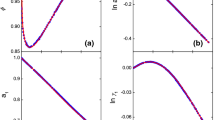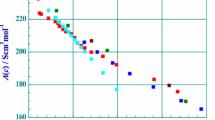Abstract
The Bjerrum association model, which has already been applied successfully to volumes and enthalpies of dilution of electrolyte solutions, has now been extended to apparent molar heat capacities and compressibilities of these systems. The proposed method of calculation, which takes into account the relaxation effect observed in second derivatives of the excess Gibbs free energy, can be used to extrapolate to infinite dilution the experimental data for systems showing a wide range of association constants in acetonitrile, propylene carbonate, and water. The concentration dependence of the thermodynamic properties can be reproduced quantitatively by the addition of one or two virial coefficients. Literature data for C P,2,ψ and K S,2,ψ of electrolytes in aprotic solvents were refitted with this equation. For dissociated or slightly associated systems (K A < 10), the standarY o2 d infinite dilution quantities () are in excellent agreement with literature values. For systems with high K A, Y o2 obtained by the model are systematically lower than those reported in the literature. This is not surprising, since the traditional method of extrapolation using the Debye–Hückel limiting law or the Pitzer equation does not take association into account. A computer software that performs the calculations for the application of the Bjerrum model to thermodynamic properties has been designed and is presented in the appendix.
Similar content being viewed by others
REFERENCES
Y. Marcus, Ion Properties (Dekker, New York, 1997).
R. Zana, G. Perron, and J. E. Desnoyers, J. Solution Chem. 8, 729 (1979).
G. Perron, A. Hardy, J.-C. Justice, and J. E. Desnoyers, J. Solution Chem. 22, 1159 (1993).
G. Perron, L. Couture, D. Lambert, and J. E. Desnoyers, J. Electroanal. Chem. 355, 277 (1993).
G. Perron, G. Trudeau, and J. E. Desnoyers, Can. J. Chem. 65, 1402 (1987).
J. I. Lankford and C. M. Criss, J. Solution Chem. 16, 885 (1987).
H. F. Holmes, R. H. Busey, J. M. Simonson, and R. E. Mesmer, J. Chem. Thermodyn. 26, 271 (1994).
I. Davidson, G. Perron, and J. E. Desnoyers, Can. J. Chem. 59, 2212 (1981).
J. I. Lankford, W. T. Holladay, and C. M. Criss, J. Solution Chem. 13, 699 (1984).
J. I. Lankford and C. M. Criss, J. Solution Chem. 16, 753 (1987).
J.-F. Côté, G. Perron, J. E. Desnoyers, G. C. Benson, and B. C.-Y. Lu, J. Solution Chem., 27, 685 (1998).
J.-F. Côté, J. E. Desnoyers, and J.-C. Justice, J. Solution Chem. 25, 113 (1996).
N. Bjerrum, K. Dan. Vidensk. Selskab. 7, 9 (1926).
P. Picker, P.-A. Leduc, P. R. Philip, and J. E. Desnoyers, J. Chem. Thermodyn. 3, 631 (1971).
J. E. Desnoyers, C. de Visser, G. Perron, and P. Picker, J. Solution Chem. 5, 605 (1976).
J.-F. Côté, G. Perron, and J. E. Desnoyers, J. Solution Chem., 27, 707 (1998).
J.-L. Fortier, P.-A. Leduc, and J. E. Desnoyers, J. Solution Chem., 3, 323 (1974).
J. G. Mathieson and B. E. Conway, J. Chem. Soc. Faraday Trans. I 70, 752 (1974).
D. G. Archer and P. Wang, J. Phys. Chem. Ref. Data 19, 371 (1990).
C. Xiao and P. R. Tremaine, J. Chem. Thermodyn. 28, 43 (1996).
D. E. White, A. L. Doberstein, J. A. Gates, D. M. Tillett, and R. H. Wood, J. Chem. Thermodyn. 19, 251 (1987).
C. C. Nathan, W. E. Wallace, and A. L. Robinson, J. Am. Chem. Soc. 65, 790 (1943).
J. D. Frantz and W. L. Marshall, Am. J. Sci. 282, 1666 (1982).
J. L. Oscarson, R. M. Izatt, P. R. Brown, Z. Pawlak, S. E. Gillespie, and J. J. Christensen, J. Solution Chem. 17, 841 (1988).
P. P. S. Saluja, R. J. Lemire, and J. C. LeBlanc, J. Chem. Thermodyn. 24, 181 (1992).
R. C. Phutela, K. S. Pitzer, and P. P. S. Saluja, J. Chem. Eng. Data 32, 76 (1987).
A. D. Pethybridge and S. S. Taba, J. Chem. Soc. Faraday Trans. I 176, 368 (1980).
G. Perron, J. E. Desnoyers, and F. J. Millero, Can. J. Chem. 53, 1134 (1975).
G. Perron, J.-L. Fortier, and J. E. Desnoyers, J. Chem. Thermodyn. 7, 1177 (1975).
R. P. T. Tomkins, E. Andalaft, and G. J. Janz, Trans. Faraday Soc. 65, 1906 (1969).
J. Barthel, L. Iberl, J. Rossmaier, H. J. Gores, and B. Kaukal, J. Solution Chem. 19, 321 (1990).
D. F. Evans, C. Zawoyski, and R. L. Kay, J Phys. Chem. 69, 3878 (1965).
H. Roch, PhD Thesis, Universität Regensburg, Regensburg, Germany, 1991.
L. M. Mukherjee and D. P. Boden, J. Phys. Chem. 73, 3965 (1969).
J.-F. Côté, D. Brouillette, J. E. Desnoyers, J.-F. Rouleau, J.-M. St-Arnaud, and G. Perron, J. Solution Chem. 25, 1163 (1996).
A. E. Mahgoub and A. Lasson, Acta Chem. Scand. A 29, 537 (1975).
R. L. Kay, B. J. Hales, and G. P. Cunningham, J. Phys. Chem. 71, 3925 (1967).
J. K. Senne and B. Kratochvil, Anal. Chem. 43, 79 (1971).
H. L. Yeager and B. Kratochvil, J. Phys. Chem. 74, 963 (1970).
A. C. Harkness and H. M. Daggett, Can. J. Chem. 43, 1215 (1965).
G. Lancelin, B. Dubois, G. Delesalle, and B. Vandrope, J. Chim. Phys. 77, 119 (1980).
M. L. Jansen and H. L. Yeager, J. Phys. Chem. 77, 3089 (1973).
E. M. Hanna and K. Al-Sudani, J. Solution Chem. 16, 155 (1987).
P. K. Muhuri and D. K. Hazra, J. Chem. Soc. Faraday Trans. 87, 3511 (1991).
M. Salomon and E. J. Plichta, Electrochim. Acta 29, 731 (1984).
R. Zana, J. E. Desnoyers, G. Perron, R. L. Kay, and K. Lee, J. Phys. Chem. 86, 3996 (1982).
J.-C. Justice, J. Solution Chem. 20, 1017 (1991).
Rights and permissions
About this article
Cite this article
Côté, JF., Desnoyers, J.E. Application of the Bjerrum Association Model to Electrolyte Solutions. IV. Apparent Molar Heat Capacities and Compressibilities in Water and Aprotic Solvents. Journal of Solution Chemistry 28, 395–412 (1999). https://doi.org/10.1023/A:1022607928669
Issue Date:
DOI: https://doi.org/10.1023/A:1022607928669




